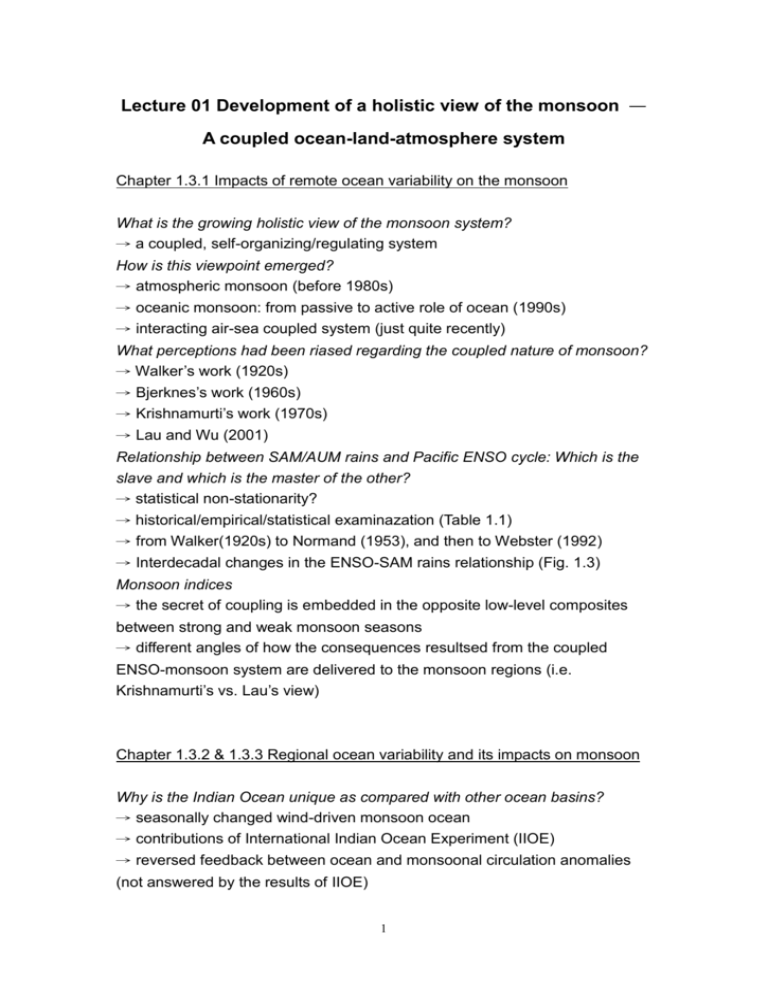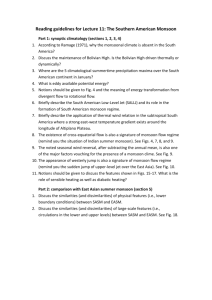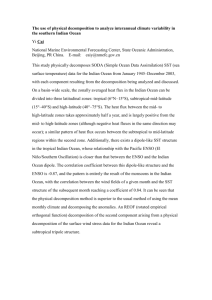Lecture 01 A holistic view of the monsoon
advertisement

Lecture 01 Development of a holistic view of the monsoon — A coupled ocean-land-atmosphere system Chapter 1.3.1 Impacts of remote ocean variability on the monsoon What is the growing holistic view of the monsoon system? → a coupled, self-organizing/regulating system How is this viewpoint emerged? → atmospheric monsoon (before 1980s) → oceanic monsoon: from passive to active role of ocean (1990s) → interacting air-sea coupled system (just quite recently) What perceptions had been riased regarding the coupled nature of monsoon? → Walker’s work (1920s) → Bjerknes’s work (1960s) → Krishnamurti’s work (1970s) → Lau and Wu (2001) Relationship between SAM/AUM rains and Pacific ENSO cycle: Which is the slave and which is the master of the other? → statistical non-stationarity? → historical/empirical/statistical examinazation (Table 1.1) → from Walker(1920s) to Normand (1953), and then to Webster (1992) → Interdecadal changes in the ENSO-SAM rains relationship (Fig. 1.3) Monsoon indices → the secret of coupling is embedded in the opposite low-level composites between strong and weak monsoon seasons → different angles of how the consequences resultsed from the coupled ENSO-monsoon system are delivered to the monsoon regions (i.e. Krishnamurti’s vs. Lau’s view) Chapter 1.3.2 & 1.3.3 Regional ocean variability and its impacts on monsoon Why is the Indian Ocean unique as compared with other ocean basins? → seasonally changed wind-driven monsoon ocean → contributions of International Indian Ocean Experiment (IIOE) → reversed feedback between ocean and monsoonal circulation anomalies (not answered by the results of IIOE) 1 Role of Indian Ocean in the classical view of the origin of SAM → a giant land-sea breeze system → plays as the cold pole of the above system → key ocean regions that affect the amount of moisture supplies → closed feedback loop between anomalous SST and anomalous winds (i.e. evidence of the cause of the SST anomalies) cannot be found Chapter 1.3.4* Intraseasonal variability and the large-scale monsoon Discovery of the existence of large-scale monsoon intra-seasonal oscillation (MISO) → active vs. break monsoon: from Ramamurthy, Rao, to Shukla → causes of MISO (Shulka) → deep tropical connection of Indian (also East Asian) MISO phenomenon: large-scale dynamical system (Webster 1998) → recent perceptions: Webster (2002), Han (2004), Wang (2004) Seasonal vs. intraseasonal climate forecasting → timing of MISO (Fig. 1.5a) and its proper regionality (Fig. 1.5b) are more crucial than the seasonal rainfall amounts to the yield of crop → “downscaling” to local climate (in both temporal and spatial resolutions) Chapter 1.3.5* Concept of the monsoon as a coupled system Large-scale and low-frequency changes in the Indian Ocean → direct wind-forcing is important to the heat storge and its meridional (i.e. poleward) transport (1980s, 1990s) → contrasting to the annual solar heating, the oceanic heat transport is northward in fall and winter; southward in spring and summer (Fig. 1.6) structual independence of Indian Ocean-monsoon system from ENSO → persistence (Fig. 1.7 a-b) → spring predictability barrier (Webster and Yang 1992) → biennial tendency of Indian Ocean SST and monsoon rains (Fig. 1.1; Meehl 1990s) → descriptions of Indian Ocean Dipole (IOD) in various variables ( Fig. 1.8) 2 Chapter 1.3.6* Emerging questions essential to the understanding of coupled Indian Ocean-monsoon system → Does the ‘natural thermostat’ hypothesis work for Indian Ocean too? (tropical cirrus clouds resulting from deep convection contribute to long-wave radiative heating of the tropospheric column, and at the same time reduce solar insolation at the sea surface, in this way cooling the ocean. This dual tropospheric, long-wave radiative heating and surface, short-wave radiative cooling role of cirrus is the central premise of the thermostat hypothesis (Ramanathan and Collins 1991). The thermostat mechanism relies upon five factors: deep convection, occurring only when the SST exceeds a threshold value, Tc ~ 27 C the super-greenhouse effect in regions where SST > Tc radiative heating variations due to cirrus and the “ factor, ” raction of cloud long- wave forcing which directly heats the surface rapid lateral heat transport in the troposphere oceanic warm pool, which is sensitive to surface energy fluxes → Can the ‘collective’ feedback processes between ocean and atmosphere regulate the annual cycle and interannual variability of the monsoon? → How are Indian Ocean SST anomalies produced? → What factors are important to the phase and amplitude of monsoon annual cycle? Internal dynamics of the Indian Ocean itself or the thermodynamical forcing of the radiative variability or the land surface processes? → What is the relative importance between the local and remote influences to the interannual rainfall variability of the SAM? → TBO; artifact or reality? → Are the IOD in the ocean and TBO in the monsoon the twin sisters? → To what extent, the MISO can be described as a coupled ocean-atmosphere phenomena? Ch. 1.4.1 Macroscale forcing of the monsoon annual cycle Evolution of the seasonal annual cycle in the Indian Ocean and SAM (Fig. 1.9) → lack of variation of SSTs between seasons → N-S thermal contrast between land and ocean (Fig. 1.10) → 3 cross-equatorial pressure gradient → cross-equatorial monsoon flow → reversing cross-equatorial Ekman heat flux → relax the N-S thermal contrast Ch. 1.4.2 Surface heating-SST tendency paradox (in the Indian Ocean) How the seasonal SST distribution in the Indian Ocean is regulated? → estimates of surface flux over the north Indian Ocean (Table 1.2) → compared with western Pacific Ocean: magnitude and seasonality → theoretical computation of heating rate (Eq. 1.2) is against the reality (Fig. 1.9) → thermostat hypothesis doesn’t work, neither the wind-evaporation feedback. → Godfrey’s (1995) conclusions Ch. 1.4.3 Role of ocean dynamics in the annual heat balance of the Indian Ocean → Model simulated heat budget in the north Indian Ocean (Fig. 1.13a) → Seasonally reversing meridional ocean circulation (McCreary et al. 1993) → Meridional ocean heat flux (Fig. 1.13.b) is balanced by the meridional atmospheric latent heat flux (Fig. 1.13.c) → neglect the [ annual cycle of two heat storage componets (Fig. 1.14) ] Ch. 1.4.4 Regulation of the annual cycle: an ocean-atmosphere feedback system → The annual cycle in the Indian Ocean is a coupled phenomenon resulting from ocean-land-atmosphere interactions. → It is balanced by the cross-equatorial oceanic heat transport accomplished by the Ekman mechanism to reduce the SST gradient between summer and winter hemispheres (Fig. 1.15) → The amplitudes of the seasonal cycle of the monsoon in the Indian Ocean are modulated through the negative feedbacks between the ocean and the atmosphere. Ch. 1.7 Holistic theory of monsoon system → Discussions of Fig. 1.40 4








